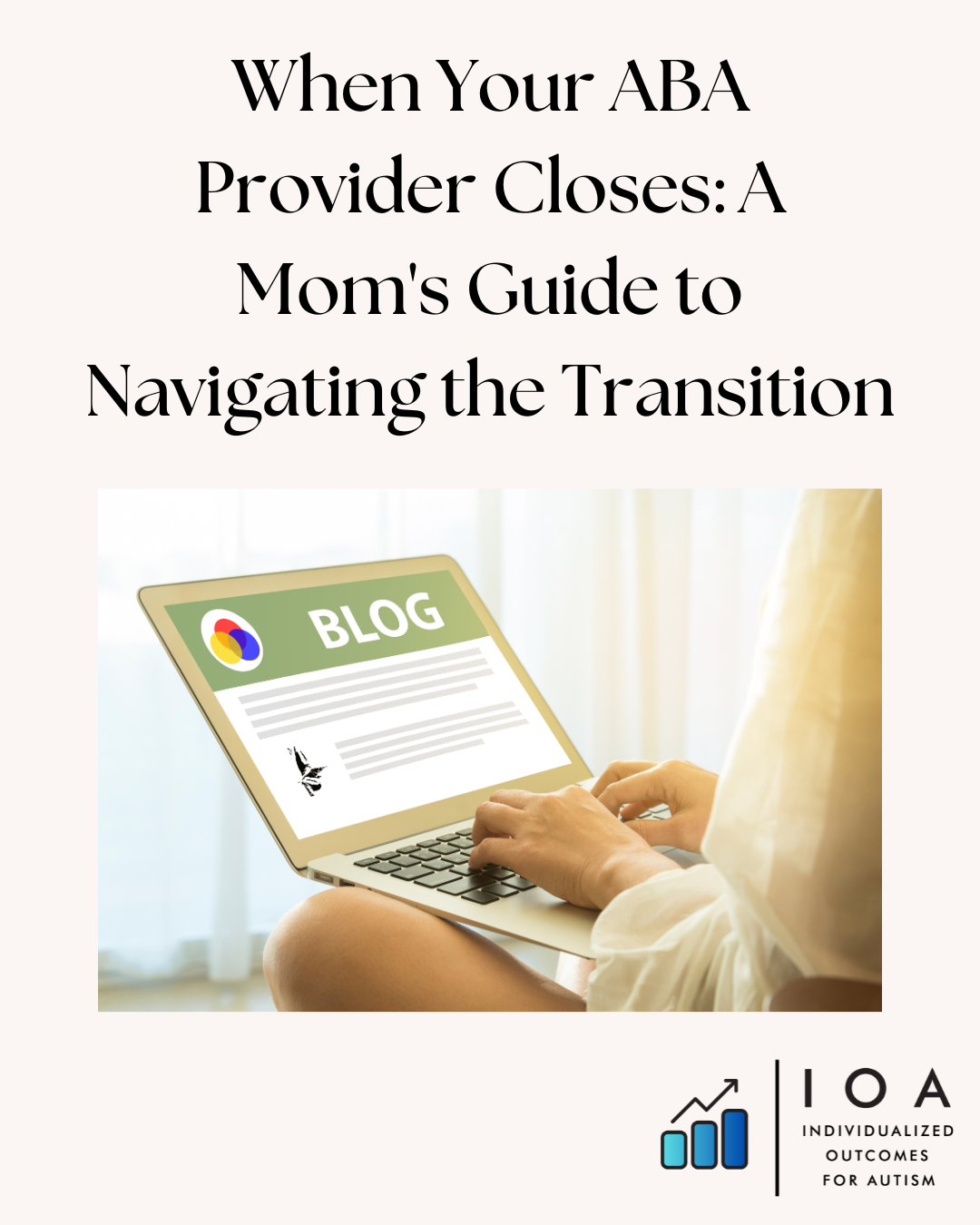When Your ABA Provider Closes: A Mom’s Guide to Navigating the Transition
By Angela Khater, MA, BCBA | Clinical Director at IOA
As an autism mom, BCBA, and advocate, I’ve seen firsthand how devastating it can be when families suddenly lose their ABA services. While thankfully our center is going strong, I’ve helped countless families through this difficult transition and wanted to create this guide for parents who might face this challenge.
I still remember sitting across from a mom in my office who had just received notice that her son’s previous ABA center was losing their insurance contract and that they only had two weeks to find a provider. The panic in her eyes was something I recognized all too well. Having been on both sides as the professional helping families transition and as the mom who’s fought insurance battles. I want to share some real-world advice that actually works.
First Steps: What to Do When You Get The News
Grab Your Child’s Records IMMEDIATELY
Don’t wait on this one. The minute you hear your provider is closing or dropping your insurance, request EVERYTHING:
Your child’s latest assessment (the full thing, not just the summary)
Current treatment plan with all progress data
Their behavior intervention plan
Program sheets showing current targets
Any discharge summaries they can provide
Trust me on this, once centers start closing, staff scatter quickly and files can get misplaced in the shuffle. I’ve seen too many parents start over from scratch because they couldn’t get proper documentation. Be “that parent” who stands at the front desk until they print everything out if you have to!
The Insurance Marathon
Put on your advocacy hat for this one:
Call your insurance immediately (keep a notebook dedicated to these calls)
Write down names of EVERYONE you talk to
Specifically ask: “What are my options for continuation of care?” (use these exact words!)
Request a complete list of in-network providers
Ask about “single-case agreements” for out-of-network providers if options are limited
One family I worked with discovered their insurance had a special exception for ABA services if their child had been receiving consistent care but the representative didn’t mention it until they specifically asked about exceptions for autism services. Insurance companies don’t volunteer information, so you have to know what to ask.
Waitlist Strategies (The Part Nobody Tells You)
Let’s be honest most ABA providers have waitlists. Here’s how to navigate them:
When calling new providers, be specific and honest: “Hi, I’m Jennifer. I’m a mom to a child with autism. Our current provider is closing in X weeks, and we absolutely cannot have a gap in services. My child has significant challenges with [specific behaviors]. Can you tell me realistically what your waitlist looks like and if there’s any possibility of priority placement?”
Other waitlist tips that actually work:
Call EVERY provider on your insurance list, not just the well-known ones
Check with local universities that might have ABA clinics
Ask about home-based options if center spots are full
Call weekly for updates (persistence pays off, one mom I know got her son placed because she called every Monday morning).
Creating Your Home Survival Plan
As both a practitioner and a mom who’s implemented home programs during service gaps, here’s what actually works:
Focus on maintaining skills rather than teaching new ones
Pick 2-3 behavior strategies that make the biggest difference and be consistent
Create visual schedules for EVERYTHING (transitions, morning routine, bedtime)
Be realistic about what you can handle while juggling everything else
When one of my client families faced a gap, we created a simplified token system that both parents and the grandparents who helped with childcare could implement consistently. Was it perfect ABA? No. Did it prevent major regression? Absolutely.
School Support During Gaps
Call an IEP meeting immediately. As an advocate who’s sat in countless meetings, I can tell you schools can often provide additional temporary support, but rarely offer unless you specifically request it:
Request additional aide time during difficult periods of the day
Ask for consultation from the district behavior specialist
Request modified expectations during the service gap
Get everything in writing!
Documentation is crucial if your child regresses during the service gap, you’ll need this paper trail for insurance appeals or future IEP meetings.
The Emotional Reality Check
Can we just acknowledge how utterly exhausting this is? As autism parents, we’re already carrying so much. Adding “find new life-changing therapy while preventing regression” to the list feels impossible some days.
Be gentle with yourself. When I was going through a transition with my own child, my house looked like a tornado hit it for weeks. The laundry piled up. We ate more takeout than I’d like to admit. And we survived.
Connect with other parents from your center who are in the same situation. When one center in our area closed, the parents created a text group to share provider leads. This parent network became an invaluable resource.
Interviewing New Providers: Trust Your Gut
After years on both sides of this field, here’s what I personally look for in a provider:
How do they respond when you ask about parent involvement? (If they seem annoyed by parent questions, that’s a huge red flag)
What’s their staff turnover like? (High turnover = inconsistent therapy)
How do they handle challenging behaviors? (Listen for approaches that respect your child’s dignity)
Do they incorporate special interests or is their approach rigid?
As both a mom and a BCBA, I can tell you that some of the most technically “perfect” ABA programs have been the worst fit for certain children. The provider who sees your child as a whole person and builds on their interests will likely create the most meaningful progress.
When Nothing Works: The Emergency Plan
Sometimes despite our best efforts, gaps happen. If you find yourself there:
Contact your developmental pediatrician for documentation of medical necessity
File a formal appeal with insurance (use terms like “risk of significant regression” and “medical necessity”)
Look into temporary respite services through local disability organizations
Consider short-term parent training with a private BCBA (even a few hours can give you strategies)
During one family’s six-week gap, we arranged twice-weekly parent coaching sessions. It wasn’t ideal, but it gave them specific strategies to maintain their child’s communication skills until new services started.
Final Thoughts
This journey is hard enough without losing services we fought so hard to get. But I’ve seen time and again that parents are more resilient and capable than they realize.
You’ve already navigated diagnosis, insurance battles, and all the daily challenges that come with raising a child with autism. This is just one more mountain, and your advocacy skills will get you through.
If you’re facing this situation, remember you’re not alone. Our autism community understands, and sometimes we have connections or ideas that might help each other out. Reach out to local support groups, online communities, and other parents who’ve walked this path.
Keep fighting for your child. Your persistence makes all the difference.

